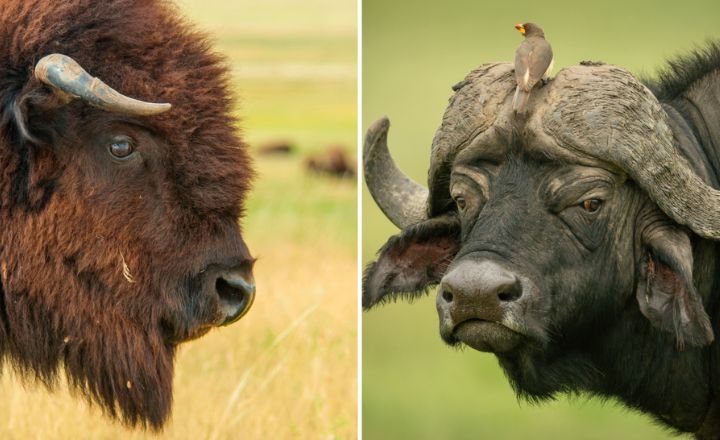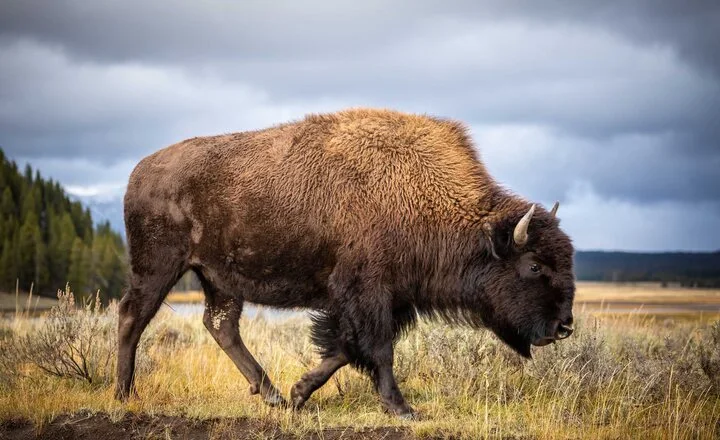The American wilderness, a common confusion persists among nature enthusiasts and casual observers alike Are Buffalo And Bison The Same ? these majestic creatures, symbolising strength and resilience, have long captured our imaginations with their imposing presence on the prairies.
Both animals share a striking resemblance, their distinctions are as nuanced as they are intriguing.
Are Buffalo and Bison the Same?
Bison, native to North America, are known for their humpbacked appearance and majestic presence on the prairies. They have robust bodies and thick fur to withstand harsh winter conditions.
Buffalo are found in Africa and Asia, often roaming vast grasslands in search of food and water. Despite their physical similarities, these animals have adapted differently to their distinct environments over time.
Are buffalo and bison the same are understandable given their shared attributes and historical significance. Both species have been hunted by humans throughout history for their meat, hides, and other resources.
A represents resilience in the face of environmental challenges and conservation efforts aimed at protecting these iconic animals from extinction.
Why The Misnomer?
The misnaming of bison as buffalo by European settlers showcases the power of first impressions and the lasting impact of such errors. It’s intriguing how superficial similarities can lead to widespread misconceptions that persist through generations.
The mistake is understandable considering the context, it highlights the importance of accurate knowledge and terminology in scientific understanding.This misnomer sheds light on the complexities of language and how words can shape our perceptions of the world around us.
Buffalo
Buffalos, with their sturdy build and distinct features, have long been valued for their contributions to human society. Water Buffalos are known for their gentle demeanour and have been domesticated in various regions for their milk production.

The rich and creamy buffalo milk is a staple ingredient in many traditional dishes, prized for its unique taste and nutritional value. Cape Buffalos roam the grasslands of Sub-Saharan Africa, showcasing a more wild and untamed nature.
Their large buffalo horns and formidable presence make them a symbol of strength and resilience in African folklore. Despite being less commonly domesticated than Water Buffalos, Cape Buffalos play a vital role in maintaining the ecosystem balance of the savannas they inhabit.
Bison
The American Bison holds a deep cultural significance for Native American tribes across the continent, who see it as a symbol of strength, resilience, and abundance. Despite facing near-extinction in the late 19th century due to overhunting and habitat loss, conservation efforts have helped populations rebound in recent years.
Visitors to national parks such as Yellowstone can witness these majestic creatures grazing on the plains, reminding us of their enduring presence in North America’s ecosystem.
The American Bison also plays a crucial role in sustainable agriculture. With growing concerns about environmental impact and animal welfare in the food industry, bison meat has emerged as a popular choice for conscious consumers looking for a healthier and more ethical alternative to conventional beef products.
How to Differentiate Between Bison and Buffalo?
Are Buffalo And Bison The Same are often used interchangeably, there are key differences that set these majestic mammals apart. One significant distinction is their physical appearance bison have larger shoulder humps and shorter horns in buffalo.

A bison typically has thicker fur, especially during the winter months, whereas buffalo have lighter coats.
Location
Location: Buffalos are revered in Asia and Africa not only for their contribution to agriculture but also for their cultural significance. In these regions, buffalos are seen as symbols of strength, resilience, and prosperity.
Are Buffalo And Bison The Same the deep bond between humans and buffalos is evident in traditional rituals, festivals, and daily life where these majestic creatures play a vital role in the livelihoods of many communities.
Habitat: It’s fascinating to compare the contrasting lifestyles of domesticated buffalos and their wild counterparts, the bison.
While domesticated buffalos enjoy a laid-back and relaxed environment, bison thrive in the face of ever-changing weather conditions, adapting effortlessly from scorching summers to freezing winters. This stark difference is a testament to how animals can evolve based on their surroundings.
Hump: This unique physical feature, the hump, serves a crucial purpose for bison in their natural habitat. It enables them to navigate through harsh winter conditions by using their head as a tool to clear snow.
This adaptation highlights the remarkable resilience and adaptability of these mighty creatures in surviving challenging environments.
The prohibition against riding buffalo and bison is not just a matter of rules and regulations; it also reflects a deeper respect for these magnificent animals.
Horns: The diverse range of horns among the bovine species is a testament to the unique adaptations each animal has developed over time. Water buffaloes stand out with their impressive six-foot-wide horns that grow sideways before elegantly curving upwards, creating a striking silhouette.
African buffaloes opt for a more robust approach with massive horns adorning the top of their heads, showcasing pronounced arcs that symbolise strength and dominance in the animal kingdom.
Size: Buffalo and bison are often confused due to their similar appearances, but subtle differences set them apart. Buffalo, with their medium frame and weight ranging from 1,300 to 2,000 lbs., are known for their strength and resilience in various environments.
Bison stand out for their significantly larger size and weight, tipping the scales between 2,200 to 2,500 lbs. This disparity in weight showcases the robust nature of these majestic creatures.
Species: The African Buffalo and Water Buffalo are the main species of buffalos globally. The African Buffalo, known for its powerful build and unpredictable nature, roams the grasslands and savannas of Africa in large herds.The Water Buffalo is domesticated in many parts of Asia for its meat, milk, and as a working animal in agriculture.
Fur: Buffalos may appear sleek and smooth, but their thin, sparse fur serves a purpose beyond aesthetics. This invisible coat provides protection from the sun’s harsh rays while allowing them to regulate their body temperature effectively.
Bison sport a shaggy, thick fur that acts as a natural insulation against the winter chill. Shedding their winter coats in the summer reveals a new layer of fur that is lighter and better suited for warmer weather.
Animals Similar to Bison and Buffalo
It includes cattle, oxen, and yaks. These animals share characteristics such as cloven hooves, horns, robust sizes, and a similar body shape to bison and buffalo. While bison have remained wild, cattle, oxen, and yaks have been domesticated by humans for various purposes such as agriculture, transportation, and food production.

The similarities between these animals go beyond just physical appearance. They all play important roles in ecosystems around the world and have been integral to human societies for centuries.
Whether roaming the grasslands of North America like bison or serving as working animals in Asia like yaks, these bovid species are essential components of our natural world.
Final Thought
Are Buffalo and Bison The Same may be similar in appearance and often used interchangeably, they are actually two distinct species with unique characteristics. Buffalo are native to Africa and Asia, while bison are native to North America.
Their physical differences, habitat preferences, and evolutionary history all contribute to their individual identities. The distinctions between buffalo and bison are important for conservation efforts and wildlife management.
FAQs
What is the difference between a buffalo and a bison?
Buffalo and bison are often confused due to their similar appearance, but they are actually two distinct species. The main difference lies in their geographic distribution and physical characteristics.
Why are buffalo now called bison?
The animal commonly referred to as a buffalo in North America is actually a bison. Bison are native to North America and are part of the Bovidae family, which includes cattle, goats, and sheep.
Can bison and buffalo mate?
No, bison and buffalo cannot mate with each other.Bison are native to North America and are commonly referred to as American bison or buffalo, while true buffalo species include the African buffalo and the Asian water buffalo.
What is a female bison called?
A female bison is called a cow. Cows are an essential part of the bison herd, playing a crucial role in reproduction and nurturing the young calves.
